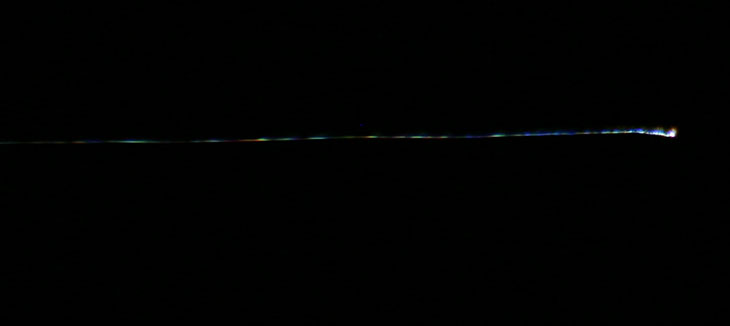
So, what is it?
I’ve had this experiment in the back of my head for a while now, and tried it last night. What you’re seeing here is Sirius, otherwise known as the Dog Star or the Dog’s Nose, and the brightest star in the sky. As a quick aside, for some reason many people think Polaris, or the North Star, is supposed to be the brightest, which would be handy but is far from the case. Also, there are brighter things in the sky at night, but they’re not stars. This distinction sometimes annoys people, but it’s worth noting, because planets are much closer and move separately from the starfield, so are in different positions each night – in fact, they change position throughout.
Part of the reason Sirius looks like this is because I panned the camera on the tripod during the one-second exposure – you can see where it began on the right side, and also that the panning was not Hollywood smooth. But the other reason is much cooler, because you’re looking at ‘twinkling.’ It really is this distinct and this fast.
Astronomers refer to this as seeing – no, this doesn’t mean just looking at something, but the atmospheric conditions that may degrade the ability to, um, see a stellar object; “the seeing is particular bad tonight.” Seriously, astronomers, get another word, it’ll save confusion – I’ll make up a few for you if you like. Because you did this, every time someone wants to talk about astronomy they have to switch to words like “view” and “observe” to avoid confusion with the technical term. Sheesh.
Now, if you (the rest of my readers, all two of them) used the term scintillation, I can’t blame you – I did too, initially, but technically, this only refers to changes in luminance (which is indeed visible here) but not to the diffraction effect that produces all the colors. Or so some sources say; it appears numerous astronomers use it to mean the color change as well, so chances are you’re not going to look like a boob if you use it this way.
What’s fun is, there’s a lot of disagreement on what’s actually happening. They all agree that it’s the air, specifically different densities and the turbulence between layers. However, some sources, including Wikipedia, state that the atmosphere splits the light into separate wavelengths from diffraction, like a prism does, but the brightness change comes from just one rod in our eyes (it should be cone anyway) receiving the light, but it wanders across different rods/cones, shifting position slightly in our eyes. That’s nonsense too, because a camera lens is much wider than a human eye and receives light from its entire front surface, focusing (recombining) it all back down to the single point on the sensor/film – the effect would be averaged out and the twinkle would vanish. We can’t even suppose that this comes from single color pixels in the sensor receiving light and no others, since a) the image is wider than a single pixel, and b) there are a lot more colors than the three in the sensor.
So the diffraction seen here is very real, and falls in a broader area – wider, at least, that the camera front element, which is roughly 73mm. But one effect very likely is due to the camera, and that’s the places where the light simply vanishes. There are two possibilities that come to mind: 1) that the light was simply dimmed or diffused enough to prevent adequate exposure in the tiny fraction of time that area of the sensor was exposed while the camera was panning, or 2) that the diffraction actually passed into the infra-red or ultra-violet which the sensor could not detect. Possibly both, though I lean towards the former because Sirius never seemed to blink out when observing it by eye, and we can’t see IR or UV either. That reasoning, however, is still in question because of the image below.
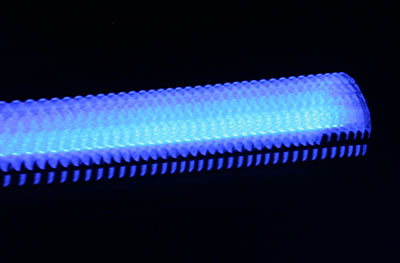 This is an LED christmas light, also taken by panning during a one-second exposure. Alternating current causes all lights to blink, and since LEDs don’t use a filament, they go out immediately rather than fading – you cannot detect this visually, but it’s revealed with a simple camera trick. If you try it with a phone camera you’ll probably get something even weirder, but that’s because phone cameras are goofy. Anyway, Sirius really could go completely black to our eyes, if it does it fast enough (see those gaps in the top image again,) and we might never know it.
This is an LED christmas light, also taken by panning during a one-second exposure. Alternating current causes all lights to blink, and since LEDs don’t use a filament, they go out immediately rather than fading – you cannot detect this visually, but it’s revealed with a simple camera trick. If you try it with a phone camera you’ll probably get something even weirder, but that’s because phone cameras are goofy. Anyway, Sirius really could go completely black to our eyes, if it does it fast enough (see those gaps in the top image again,) and we might never know it.
More than a few UFO reports involve things that change color rapidly, which supposedly are not stars because “they don’t change color that much.” Uh huh. Or, “It was bigger than that.” But go out on a clear night and take a good look – Sirius, Vega, Spica, and others all look larger because they’re significantly brighter – this isn’t something I’m able to demonstrate easily because, in the camera, they will be larger, but that’s due to flare from the lens. And yes, it’s possible that the eye’s lens produces flare too, though this is a little hard to prove (let me remove yours for a few hours and we’ll run some tests.) At some point, I’ll shoot both Venus and Sirius at the same magnification and demonstrate how much larger Venus actually is, even though many observers would say Sirius is at least the same size.
Anyway, it’s a cool effect, and maybe later on I’ll try it with a cluster like Pleiades. In the meantime, I’ll refer you back to a previous ‘Too Cool’ post on the Horsehead Nebula, and a recent Astronomy Picture of the Day which places it in reference to Orion’s Belt and Cellphone – it would have been nice if this was available when I was composing that post.





















































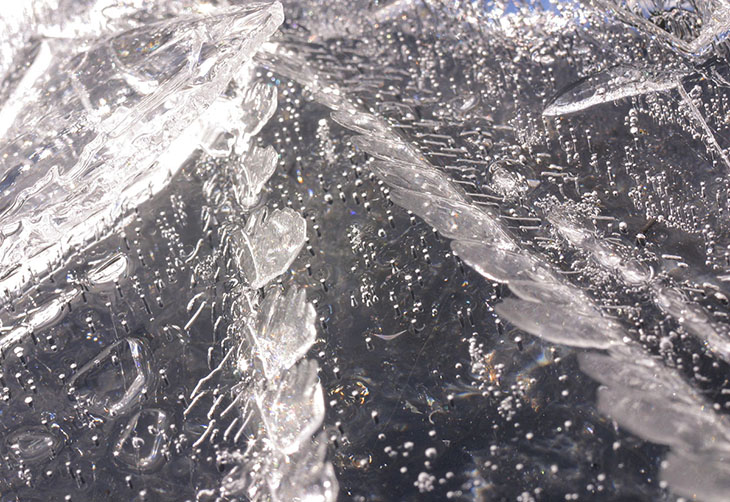

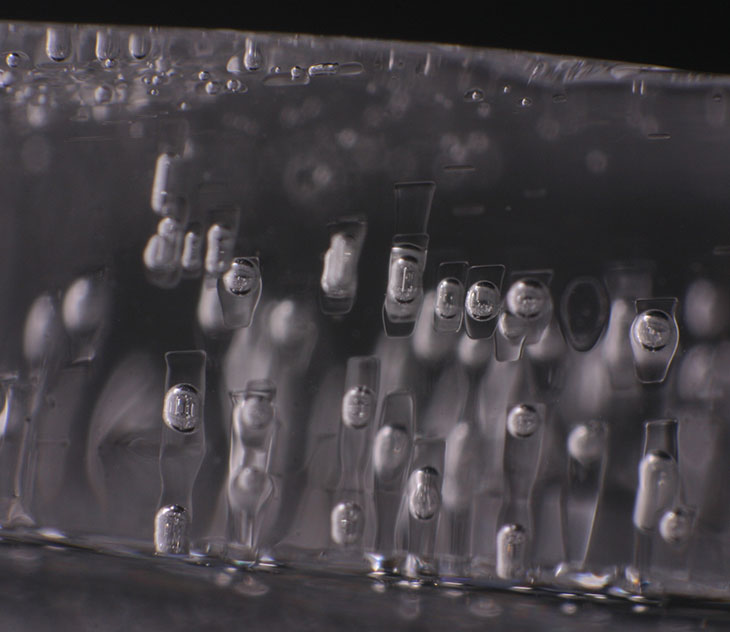



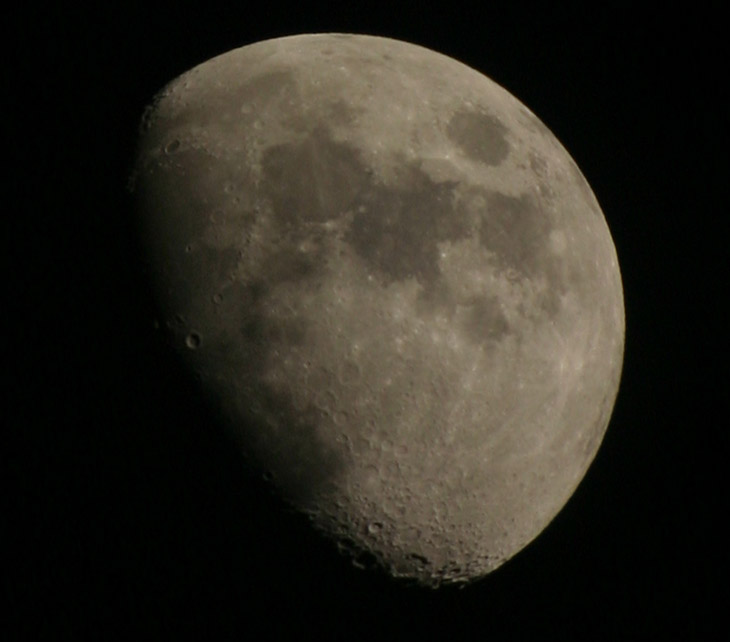
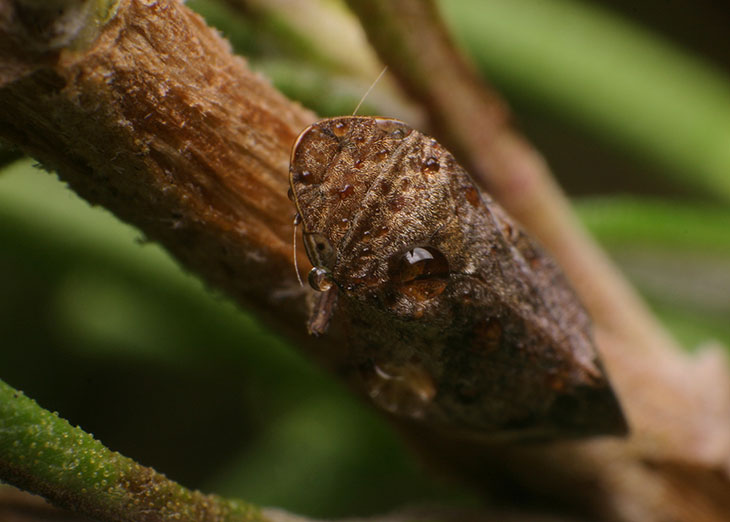
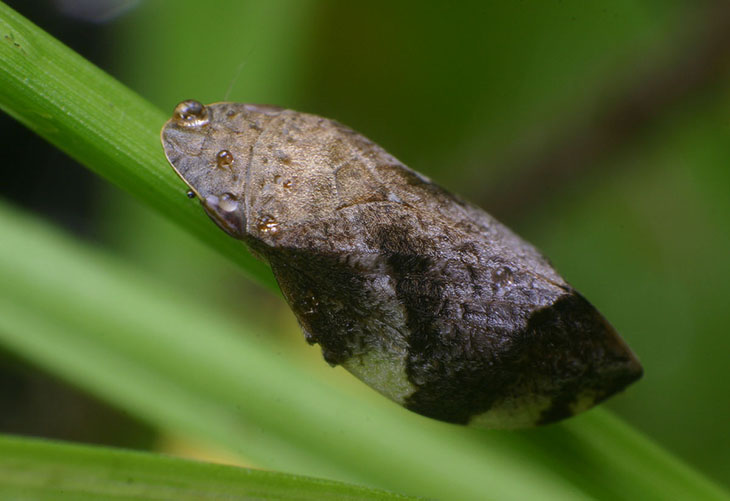
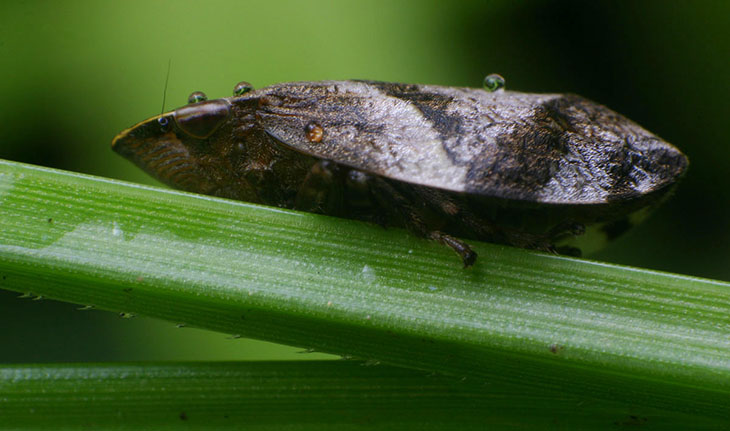
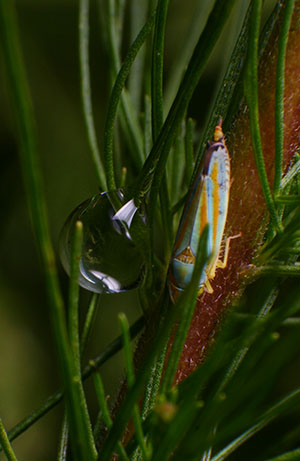 Do you get the impression that their exoskeleton is good at repelling water? It’s actually incredibly good – they coat themselves with an internally-produced substance called
Do you get the impression that their exoskeleton is good at repelling water? It’s actually incredibly good – they coat themselves with an internally-produced substance called 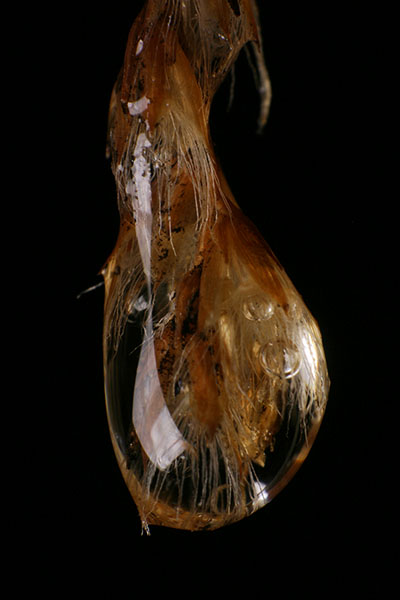 I hadn’t originally intended to include most of that above – it came from suddenly recalling Ed Yong’s article while thinking about those water drops. What was intended was to include this other image from the same photography session, a lone raindrop hanging from the tip of the dog fennel flowers (
I hadn’t originally intended to include most of that above – it came from suddenly recalling Ed Yong’s article while thinking about those water drops. What was intended was to include this other image from the same photography session, a lone raindrop hanging from the tip of the dog fennel flowers (
 I also did lots of other night experiments, but none of them turned out quite the way I wanted; getting the light balanced for night exposures can be tricky, and the LCD on the camera is only partially useful in that regard – it doesn’t give a very good idea of exposure levels, especially not subtleties. During this I was trying to figure out why some of the images seemed to be coming up blurred, almost in a fog, while others were sharp without changing focus at all, until I realized my breath was sometimes fogging up the LCD ;-)
I also did lots of other night experiments, but none of them turned out quite the way I wanted; getting the light balanced for night exposures can be tricky, and the LCD on the camera is only partially useful in that regard – it doesn’t give a very good idea of exposure levels, especially not subtleties. During this I was trying to figure out why some of the images seemed to be coming up blurred, almost in a fog, while others were sharp without changing focus at all, until I realized my breath was sometimes fogging up the LCD ;-) A tripod would have been no real help with this one – it wasn’t the movement of the camera that was the biggest problem, but the gentle bobbing of the saturated plants in the breeze, so the “take lots of frames” technique was the only thing I could count on. In the foreground are the remains of the
A tripod would have been no real help with this one – it wasn’t the movement of the camera that was the biggest problem, but the gentle bobbing of the saturated plants in the breeze, so the “take lots of frames” technique was the only thing I could count on. In the foreground are the remains of the 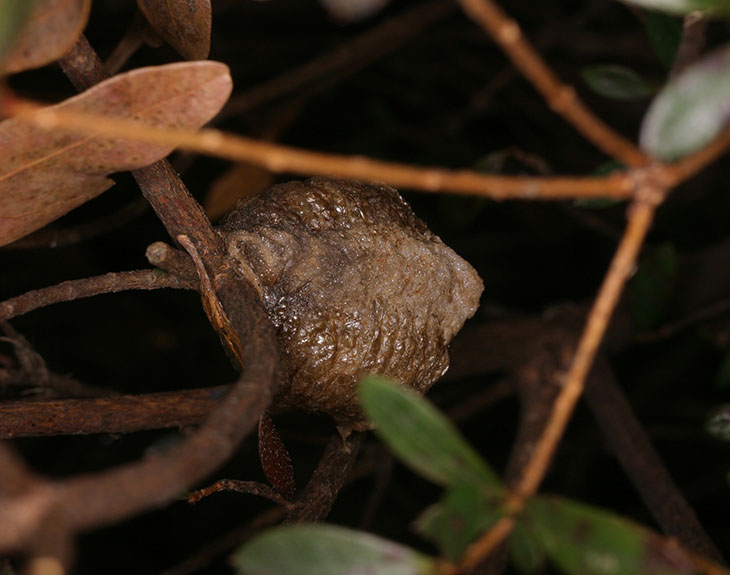
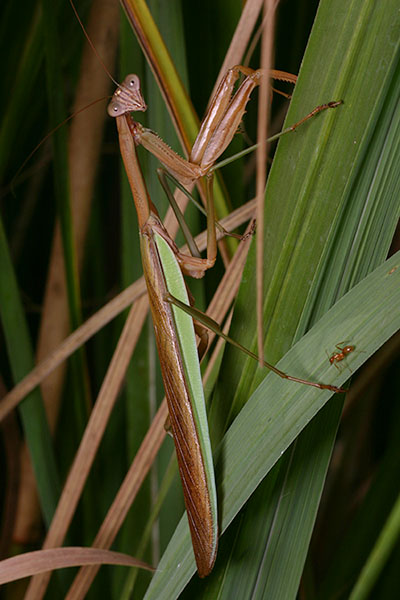 Then she reappeared with a much more trim figure, and I knew I had missed it. In the days leading up to this, she had been found newly molted on one of the front patches of pampas grass (there are three, of two different species,) then spotted on the butterfly bush, a tomato plant, the rosemary bush (where she likely ate one of the
Then she reappeared with a much more trim figure, and I knew I had missed it. In the days leading up to this, she had been found newly molted on one of the front patches of pampas grass (there are three, of two different species,) then spotted on the butterfly bush, a tomato plant, the rosemary bush (where she likely ate one of the 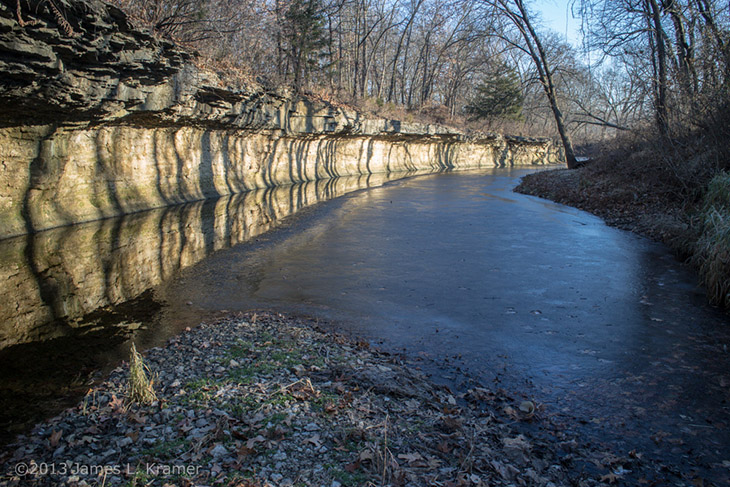

 Sometimes, the surface is as fine as a spider web, which are the best conditions to watch for because a frost-covered orb web is a great photo subject, as you might imagine. I have yet to find all those conditions in place myself – orb webs are often long gone by the time the frost conditions roll in – and to the best of my knowledge Jim hasn’t found them either.
Sometimes, the surface is as fine as a spider web, which are the best conditions to watch for because a frost-covered orb web is a great photo subject, as you might imagine. I have yet to find all those conditions in place myself – orb webs are often long gone by the time the frost conditions roll in – and to the best of my knowledge Jim hasn’t found them either. Which should make the conditions of this next image very obvious – I’m guessing that Jim was working just as the sun broke through, because there’s still frost visible and I imagine it didn’t last long. Either that or it was freakin’ cold. As indicated in the previous post, these are higher contrast conditions – note the bright highlights and distinctive shadows, giving some enhancement to the shape of this seed pod. It also made the bare branches in the background stand out a bit sharper, slightly distracting – much more and it would be working against the image too strongly. Ideally, this is where you try to find a dark background, like a patch of shade, to position behind the seed pod, using that contrast to really make it stand out, but such things can be hard to accomplish. Here’s a sneaky little trick, if you’re prepared: put the camera on a tripod, using a remote shutter release if necessary, and use your own shadow to provide the darker background.
Which should make the conditions of this next image very obvious – I’m guessing that Jim was working just as the sun broke through, because there’s still frost visible and I imagine it didn’t last long. Either that or it was freakin’ cold. As indicated in the previous post, these are higher contrast conditions – note the bright highlights and distinctive shadows, giving some enhancement to the shape of this seed pod. It also made the bare branches in the background stand out a bit sharper, slightly distracting – much more and it would be working against the image too strongly. Ideally, this is where you try to find a dark background, like a patch of shade, to position behind the seed pod, using that contrast to really make it stand out, but such things can be hard to accomplish. Here’s a sneaky little trick, if you’re prepared: put the camera on a tripod, using a remote shutter release if necessary, and use your own shadow to provide the darker background.